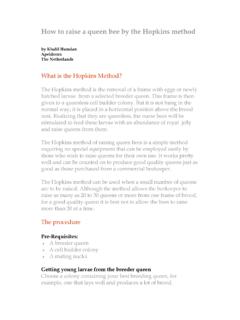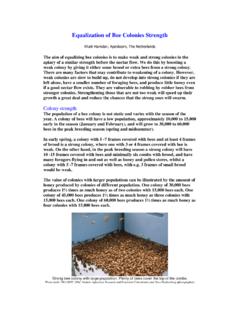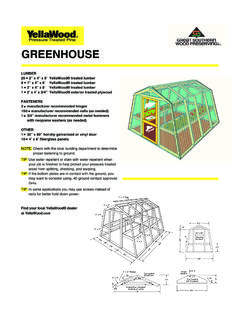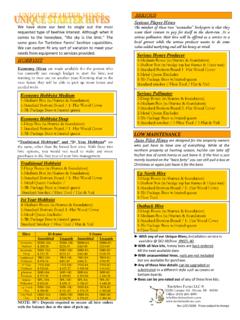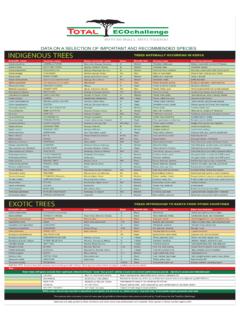Transcription of By Khalil Hamdan, Apeldoorn, The Netherlands
1 How to maximize honey production By Khalil hamdan , apeldoorn , The Netherlands One of the main reasons for keeping bees is to harvest the honey that bees store in their hives. Honey yield fluctuates from one year to another and varies between colonies. Some colonies of bees will be active during the season foraging and store more honey, some will be less active and produce little honey. The amount of honey produced per colony depends on a number of factors. The most important factors that affect honey production are: - Availability of bee pasture - The queen s condition - Hive population - Nutrition - Swarming - Space in the hive for expansion of the brood nest and storage of honey - The colony s freedom from disease - The beekeeper s experience - The weather Adequate nectar producing plants and trees, colonies with vigorous queens and large number of foraging bees, proper hive management techniques and favourable weather conditions will ensure greater honey crop.
2 Ways to help achieve high honey yields 1. Choose a good location with good nectar producing plants and trees for the bees to forage. The most important honey-producing plants and trees are citrus, apple, apricot, plum, peach, cherry, pomegranate, guava, prickly pear, banana, loquat, carob, chestnut, jujube (zizyphus spp), broad bean, peas, bean (phaseolus vulgaris), eggplant, cucumber, melon, strawberry, sunflower, cotton, sesame, anise, fenugreek, chick pea, lentil, mustard, lucerne, borage, flax, eucalyptus, robinia, acacia, willow, thyme, rosemary, lavender and thistles. 2. Locate hives near nectar sources within a mile radius. This is the economical distance for honey gathering. Bees fly two miles to find food, but honey production increases if nectar is nearby. beehives set in a cherry orchard.
3 Hives located near the nectar source; combs will soon fill with honey (Image credit: ) 3. Locate hives about 3 -5 km away from other big apiaries in the area to secure the maximum output of honey, and 1 -2 km between small apiaries (small number of hives) in rich nectar fields. Putting bee yards closer is not good management. Do not overstock at one spot. Overstocking will lead the hives to compete for the forage and as a result produce low honey harvests. As a rule of thumb, put 1-2 hives per acre (4000 sq metres) of blooming trees or crops for maximum production. This depends on the attractiveness of crops and the strength of colonies. 4. Colonies should be headed with good queens. A queen bee lives about five years or longer, but egg-laying decreases significantly after her third year, which weakens the colony and reduces the honey production, and for this reason most beekeepers replace queens at the end of their second year in honey production colonies.
4 Check now and then to see if the queen is laying eggs. If she is not, she is too old and needs to be replaced with a new one. A young queen in full lay in early season will assist the colony in building up strong populations capable of collecting a large honey crop. Some colonies may continue to have high production in their 3rd year and are still going strong into their 3rd years, but then you expect them to swarm or supersede. Bees replace a failing or an old queen with a more efficient queen by building a few supersedure cells near the centre of the comb. If only a few queen cells are found on the face of the comb during hive inspection, do not destroy them; these are supersedure cells and indicate a failing or an old queen. Allow them to develop. It is better to allow the bees to replace the queen than to purchase a new queen.
5 5. Strong colonies produce more honey: Prepare colonies to build up to full strength in time for the start of the bloom of major nectar-producing plants by feeding colonies sugar syrup 1 part sugar, 1 part water six weeks before the nectar flow begins to incite bees to brood activity. Use top feeders (slow feeding) with small holes punched in the lid of a can, plastic pail or glass jar. Invert the feeder on the bar tops of the brood nest in the hive. The bees suck the syrup from the feeder via the small perforations. It takes about 42 days for an egg to develop into a forager bee. Colonies that build up their peak populations during or after the main nectar flow will usually produce small honey crop. This is due to the small foraging force and the fact that they spend most of their time gathering food for feeding the brood.
6 A strong healthy colony will have 40,000 - 60,000 bees or more in spring. In mild warm regions, February is the time when beekeepers should prepare their colonies for the major nectar flow in spring. Provide colonies with combs when brood extends over 4 or 5 frames. This gives space for the queen to lay eggs and the brood nest to expand and to avoid over crowding. Overcrowding can result from too many young bees, combs filled with pollen and honey, and lack of supers. Check beehives every 7 10 days to see how they are developing. If a colony is getting crowded and has 7 or more frames covered with bees, a second brood box should be added over the bottom box. Managing bee colonies for population build-up before nectar flow starts is a priority. More bees=more honey. (Photo source: NY ) A strong bee colony.
7 A strong bee colony makes a big crop of honey (Photo credit: USA ARS Honey Bee Breeding, Genetics & Physiology Research Lab. Baton Rouge, Louisiana) 6. Bees must have access to water close to the hives. They need water to dilute honey and cool the hive during hot weather. If water is nearby, they can spend more time gathering nectar and less time collecting water. 7. Add supers with drawn combs when the nectar flow starts in the area. When the first super is two thirds full, add an empty super between the brood box and the two-thirds full super. Add enough supers to accommodate incoming nectar and the large bee populations, this stimulates foraging and limits early swarming. Do not add too many supers at one time. It is important to know the time of a honey flow in the area so that you can add extra combs to allow enough space in time for the storage and ripening of nectar into honey be bees.
8 Supers are stacked above the brood chamber for honey storage Photo credit: Bee yard of Honey Gardens Apiaries. St. Lawrence River valley, Upstate New York State, 8. Remove full supers and extract as soon as they are ready and return to the hives. 9. Dispense with queen excluders: They hinder the work speed of bees and slow the process of honey storing in supers. 10. Control swarming: Swarming reduces honey production due to the loss of bees, as the old queen leaves, taking more than 30-60 percent of the bees of the parent colony. The most important factors that cause swarming are the presence of a queen more than a year old and congestion in the hive (populous colony). The signs of swarming are large numbers of queen cells being constructed, large numbers of drones being raised and hive congestion.
9 The more common ways of preventing and controlling swarming are: Requeening: Use young queens. A colony with a new young queen is less likely to swarm. A colony with an older queen has about a 30% tendency to swarm. Changing the old queen in autumn or early in the year with a young one is an ideal way to suppress swarming. Removal of queen cells: Inspect the brood nest during the swarming season regularly every 7-10 days to make sure that queen cells have not been built. Once queen cells are found, all queen cells are destroyed before they hatch. Providing sufficient space to: Bees need space (extra combs and boxes) to rear brood and store honey and pollen during the active season. When a colony grows too big and becomes crowded and has shortage of space it is likely to swarm.
10 Congestion is may be relieved by taking a few brood combs into a weaker hive that you wish to strengthen or by making a nucleus. The nucleus can be added back to the parent colony later in the season, when the risk of swarming is over. You can reduce the likelihood of swarming by adding supers to the hive. Demaree method: It is an effective method to stop the bees from getting to the point of swarming. The method involves the separation of the queen from the brood. Remove the hive from its stand and place over the bottom board a new box. Transfer one open brood comb with larvae and eggs with the queen on it and a couple of combs of honey and pollen to the new box. Place the open brood comb with the queen on it in the centre; the combs of honey and pollen at the edge, then fill the empty space with frames of drawn combs or foundation.
